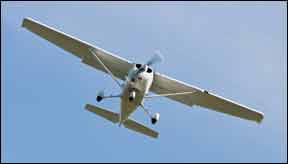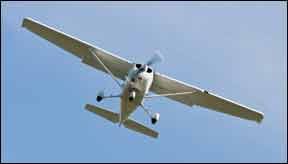One of the first few things primary students learn is the stall. More accurately, we learn how to enter them and recover from them, the idea being to avoid them and, when we can’t do that, to survive the event. At first, all these stalls are more or less straight ahead. But as we gain time and experience, our fiendish instructor will introduce other types of stalls, like the cross-controlled variety we might get into when botching a turn from base to final in the pattern. You probably mastered straight-ahead stalls early on—you wouldn’t have gotten very far in your training if you hadn’t—and were trained to avoid the cross-controlled variety by carefully planning and executing your turns when low and slow, like when in the traffic pattern.

288
Along the way, you also were introduced to accelerated stalls, the kind you can get into when exerting more than a 1g load on the airplane. From this introduction to accelerated stalls, you should have learned two things: First, the airplane can be made to stall at any speed, not just at the bottom of the white arc, because the wing’s angle of attack is what determines when the stall occurs, not airspeed. The other thing you should have learned is the accelerated stall can be much more abrupt and violent than the straight-ahead variety. Those two characteristics are worth exploring in greater detail. But before we dive into accelerated stalls, let’s get through a quick, general review of stalls.
Stalls 101
According to the FAA’s Pilot’s handbook of Aeronautical Knowledge, FAA-H-8083-25A, “An aircraft stall results from a rapid decrease in lift caused by the separation of airflow from the wing’s surface brought on by exceeding the critical [angle of attack, or] AoA. A stall can occur at any pitch attitude or airspeed.” Yes, there is a strong correlation between airspeed and when a stall occurs, but that’s only because to maintain the stalling speed in level flight, we must increase the angle of attack. How far the angle of attack must be increased before a stall occurs is, for obvious reasons, called the wing’s critical angle of attack.
The wing’s ability to stall at any airspeed is a critical concept when considering stalls and, especially, the accelerated kind. That’s because, according to the definition we’ll get to in a moment, accelerated stalls occur at an airspeed greater than the airplane’s published stalling speed, sometimes much greater.
Putting it another way, maintaining an airspeed greater than a specific airplane’s stalling value, whether VS or VS0, does not in and of itself prevent us from entering a stall. Those published speeds, represented by the bottoms of the airspeed indicator’s green and white arcs, respectively, only apply in straight-and-level, coordinated flight. As always, we must avoid exceeding the wing’s critical AoA if we want it to keep flying. Depending on the airplane, that critical AoA, beyond which the wing will stall, every time, is found between 16 and 20 degrees.
Recovering from an imminent or fully developed stall always involves reducing the angle of attack and adding full power, if it’s available. However, power is not critical to stall recovery, presuming adequate altitude remains for the pilot to reduce the wing’s AoA and allow airspeed to build back to some higher, safer value.
Defining Accelerated Stall
An accelerated stall, meanwhile, is one occurring when the airplane is experiencing a load factor greater than one. This can occur in a steep, level turn, for example, or when recovering from a dive. In other words, an accelerated stall can occur whenever the pilot demands the airplane support more than its own weight.
How? By exceeding the critical AoA. The trick is that to maintain altitude in, for example, a steep turn where the g-loading exceeds one, we must increase the wing’s angle of attack to compensate for the additional weight we’re asking it to support. The additional g-loading comes to us courtesy of centrifugal force.
As we know from basic aerodynamics, the wings must support not only the airplane’s total weight but also any additional weight imposed by centrifugal force resulting from our maneuvering. The same is true when pulling out of that dive. Whenever we add g-loading to the airframe, we must increase the wing’s AoA to compensate if we are to maintain level flight. That’s why back pressure on the pitch control is mandatory to maintain altitude when we’re performing steep turns. Once we do, we’ve edged closer to the critical AoA.
So, in a roughly 60-degree banked turn imposing approximately 2g on the airframe, the wings are being asked to support twice the weight of straight-and-level flight. To produce the extra lift needed, the AoA must be increased, reducing the margin below the wing’s critical AoA. Eliminate enough of that margin and a stall occurs, an accelerated stall, to be exact.
Behavior
An airplane’s behavior in an accelerated stall is identical to when performing one in straight-and-level flight. However, that behavior will be more “enthusiastic.” The actual stall break will be sharper and the airplane will pitch downward more suddenly. Any pre-stall aerodynamic buffet will be more aggressive and, perhaps, shorter in duration. As with so many other things we might do in an airplane, coordination matters, too.
This is another occasion when understanding slips and skids comes in handy. For example, if the airplane is slipping toward the inside of the turn when the accelerated stall occurs—the inside wing is flying slightly faster or with a lower AoA than the outside—the airplane will tend to fall off on the outside wing, which will stall before the inside one.
Conversely, a skidding turn, where the outside wing is moving faster and/or has a reduced AoA, the stall “break” will tend to be toward the inside of the turn and the airplane will roll in that direction. Both slipping a skidding in an accelerated turn can encourage a spin, of course. To prevent this behavior, fly the accelerated stall demonstration with coordinated rudder.
Why Bother?
Performing accelerated stalls isn’t perhaps the most pleasant way to spend time in an airplane. Yet, the accident record demonstrates pilots routinely engage in maneuvering flight, sometimes close to the ground.
Maneuvering, of course, involves climbs, descents and turns instead of “boring” straight-and-level flight. Of those four basic maneuvers we can perform in an airplane, turning involves increasing the airplane’s g-loading. So does exerting a nose-up pitch moment, as when recovering from a descent or initiating a climb.
The extent to which g-loading is imposed by a climb or when pulling out of a descent depends on how much force is applied or, put another way, how quickly we want to change the airplane’s attitude. A smooth, gentle entry into a climb might barely tickle an installed g-meter while establishing a climb by aggressively yanking back on the pitch control definitely will. The same is true when we want to establish straight-and-level flight during a descent.
Abrupt, aggressive control movement is guaranteed to generate additional g-loading, yet another reason pilots should fly with smooth, fluid control inputs. In our experience, the typical maneuvering accident involves either running into something because of low flying or entering a stall—usually an accelerated one—without sufficient altitude with which to recover. There’s little reason for the former, except showing off. On the off chance you survive the low flying, maybe you now have a better understanding how abrupt maneuvering can stall the airplane, sometimes with too little room for recovery.
0512-OF-ANGLES-AND-MARGINS.pdf




